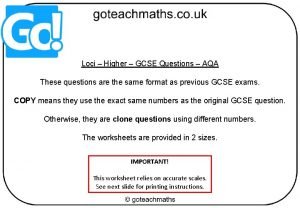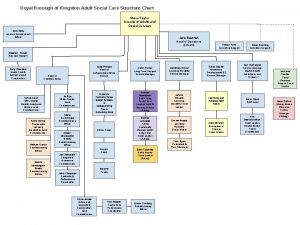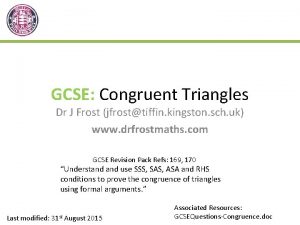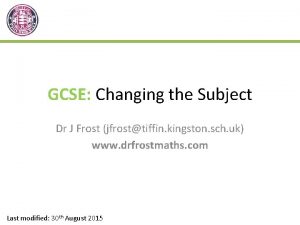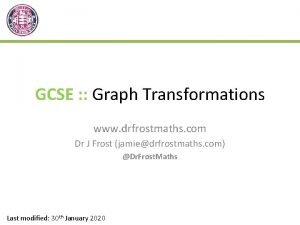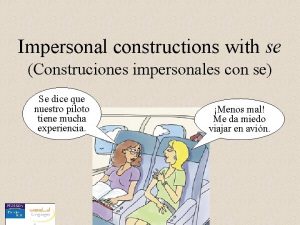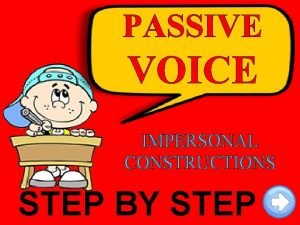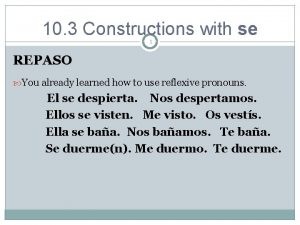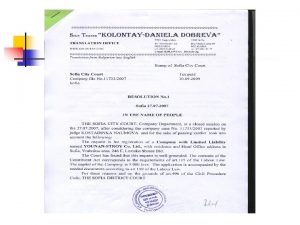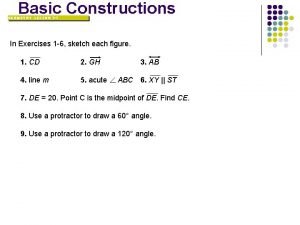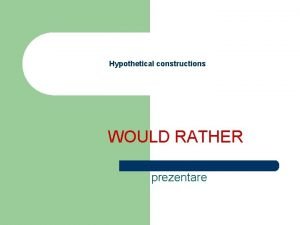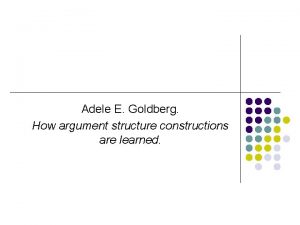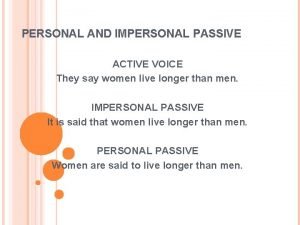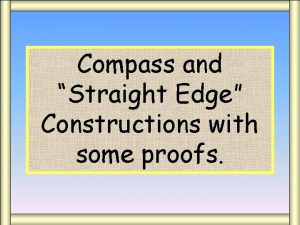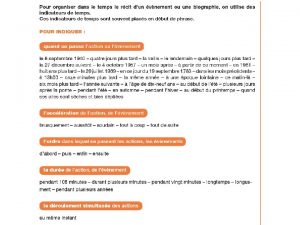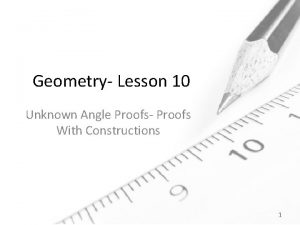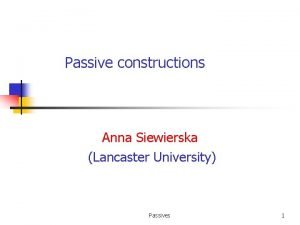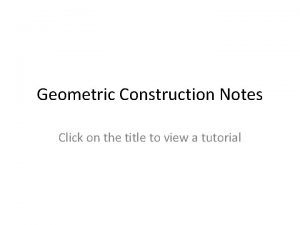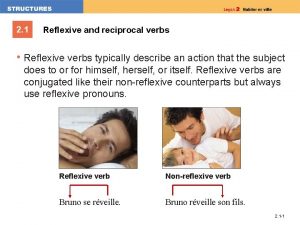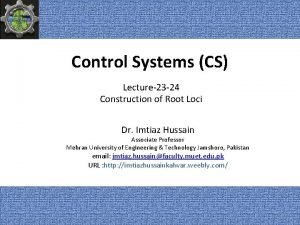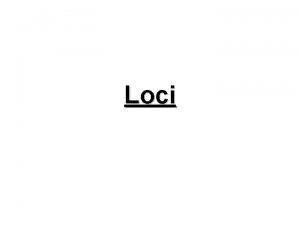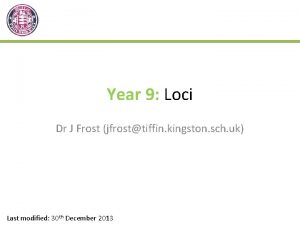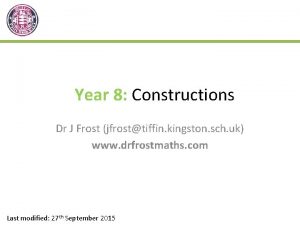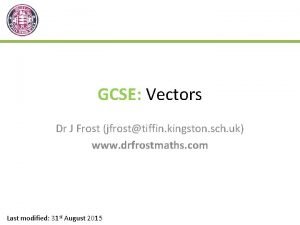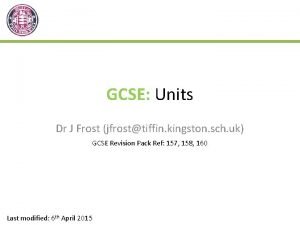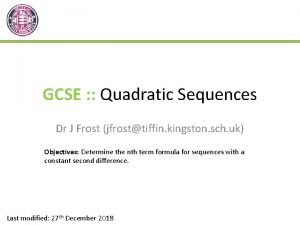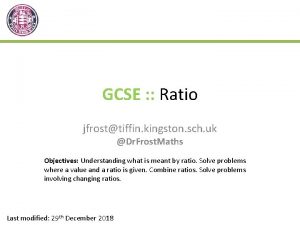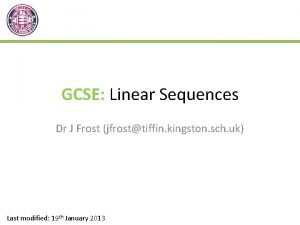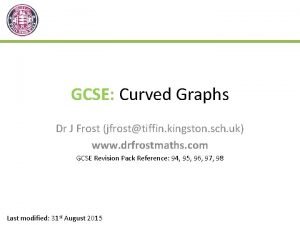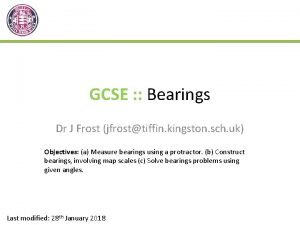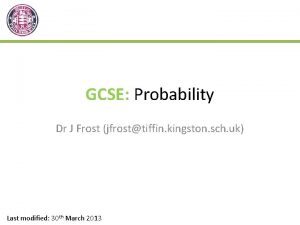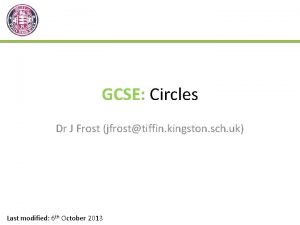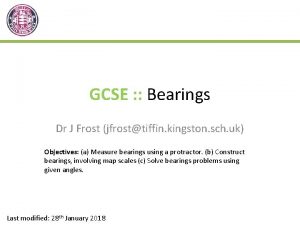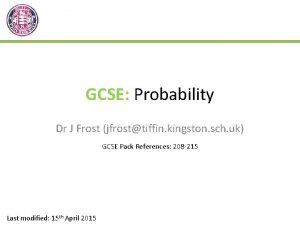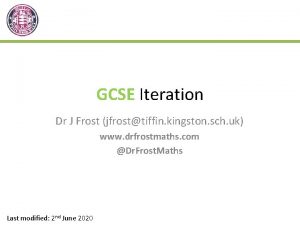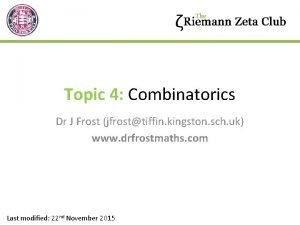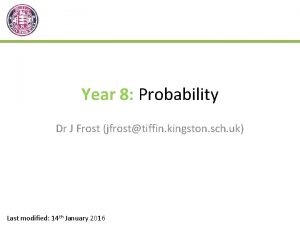GCSE Constructions Loci Dr J Frost jfrosttiffin kingston



































- Slides: 35

GCSE: Constructions & Loci Dr J Frost (jfrost@tiffin. kingston. sch. uk) Last modified: 28 th December 2014

Everything in the GCSE specification • • Construct triangles including an equilateral triangle Construct the perpendicular bisector of a given line Construct the perpendicular from a point to a line Construct the perpendicular from a point on a line Construct the bisector of a given angle Construct angles of 60º, 90º , 30º, 45º Construct a regular hexagon inside a circle Construct: -a region bounded by a circle and an intersecting line - a given distance from a point and a given distance from a line - equal distances from 2 points or 2 line segments - regions which may be defined by ‘nearer to’ or ‘greater than’

Constructions To ‘construct’ something in the strictest sense means to draw it using only two things: ? ? Straight Edge Compass

Skill #1: Perpendicular Bisector Draw any two points, label them A and B, and find their perpendicular bisector. A STEP 2: Using the same distance on your compass, draw another arc, ensuring you include the points of intersection with the other arc. B STEP 1: Put your compass on A and set the distance so that it’s slightly more than halfway between A and B. Draw an arc. STEP 3: Draw a line between the two points of intersection.

Common Losses of Exam Marks A A B B Le Problemo: Arcs don’t overlap enough, so points of intersection ? to draw line through is not clear. Le Problemo: Locus is not long enough. (Since it’s actually infinitely long, we want to draw it sufficiently long to suggest it’s infinite) ?

Skill #2: Constructing Polygons a. Equilateral Triangle Draw a line of suitable length (e. g. 7 cm) in your books, leaving some space above. Construct an equilateral triangle with base AB. Click to Brosketch Draw two arcs with the length AB, with centres A and B. A B

Skill #2: Constructing Polygons b. Other Triangles “Construct a triangle with lengths 7 cm, 5 cm and 4 cm. ” (Note: this time you do obviously need a ‘ruler’!) Click to Brosketch 5 cm 4 cm A 7 cm (It’s easiest to start with longest length) B

Skill #2: Constructing Polygons c. Square Click for Step 1 Click for Step 2 With the compass set to the length AB and compass on the point B, draw an arc and find the intersection with the line you previously drew. A Click for Step 3 B Extend the line and centering the compass at B, mark two points the same distance from B. Draw their perpendicular bisector.

Skill #2: Constructing Polygons c. Hexagon Start by drawing a circle with radius 5 cm. Click for Step 1 A B Click for Step 2 Click for Step 3 Make a point A on the circle. Using a radius of 5 cm again, put the compass on A and create a point B on the circumference.

Constructing a Regular Pentagon (No need to write this down!)

What about any n-sided regular polygon? (Note that the power of 2 may be 0) Q: List all the constructible regular polygons up to 20 sides. 3, 4, 5, 6, 8, 10, 12, 15, 16, ? 17, 20 ?

Skill #3: Angular Bisector Now draw two lines A and B that join at one end. Find the angular bisector of the two lines. A STEP 1: Use your compass the mark two points the same distance along each line. STEP 2: Find the perpendicular bisector of the two points. The line is known as the angle bisector because it splits the angle in half. B

Skill #4: Constructing Angles Click to Brosketch Some as constructing equilateral triangle – only difference is that third line is not wanted. A B

Skill #4: Constructing Angles Click to Brosketch A B

Skill #4: Constructing Angles Click to Brosketch Same as constructing a square, except you won’t need other line or additional arcs. You will be told what point to construct angle at (in this case A) A B

Skill #4: Constructing Angles Click to Brosketch A B

Skill #5: Construct the perpendicular from a point to a line You know how to find the perpendicular bisector. But how do you ensure it goes through a particular point? Click for Step 1 Click for Step 2 Find perpendicular bisector of these two points. Centre compass on point and mark two points with the same distance on the line.

Skill #6: Construct the perpendicular from a point on a line Click for Step 1 Click for Step 2 Find perpendicular bisector of these two points. Centre compass on point and mark two points with the same distance on the line.

Overview • • • • • Construct triangles including an equilateral triangle Construct the perpendicular bisector of a given line Construct the perpendicular from a point to a line Construct the perpendicular from a point on a line Construct the bisector of a given angle Construct angles of 60º, 90º , 30º, 45º Construct a regular hexagon inside a circle Construct: -a region bounded by a circle and an intersecting line - a given distance from a point and a given distance from a line - equal distances from 2 points or 2 line segments - regions which may be defined by ‘nearer to’ or ‘greater than’ ‘Loci’ stuff we’re doing next lesson.

Loci ! A locus of points is a set of points satisfying a certain condition. We can use our constructions from last lesson to find the loci satisfying certain conditions… Loci involving: Thing A Thing B Interpretation Point - A given distance from point A Line - A given distance from line A Point Equidistant from 2 points or given distance from each point. Line Equidistant from 2 lines Point Line Equidistant from point A and line B Resulting Locus A ? ? A Perpendicular bisector A B A ? ? Angle bisector B A ? Parabola B

Regions satisfying descriptions Loci can also be regions satisfying certain descriptions. Click to Broshade Moo! 3 m 3 m Click to Broshade A goat is attached to a post, by a rope of length 3 m. Shade the locus representing the points the goat can reach. A B A goat is now attached to a metal bar, by a rope of length 3 m. The rope is attached to the bar by a ring, which is allowed to move freely along the bar. Shade the locus representing the points the goat can reach. Shade the region consisting of points which are closer to line A than to line B. Click to Broshade Common schoolboy error: Thinking the locus will be oval in shape. As always, you MUST show construction lines or you will be given no credit.

Examples Q R Scale: 1 m : 1 cm 2 m 2 m Circular corners. 10 m Straight corners. 2 m 10 m

Examples Q I’m 2 m away from the walls of a building. Copy the diagram (to scale) and draw the locus. Ensure you use a compass. Scale: 1 m : 1 cm 2 m 6 m 10 m Click to Broshade 6 m 10 m

Examples Q Scale: 1 m : 1 cm My goat is attached to a fixed point A on a square building, of 5 m x 5 m, by a piece of rope 10 m in length. Both the goat and rope are fire resistant. What region can he reach? R 10 m A 5 m Click to Broshade Bonus question: What is the area of this region, is in terms of ? 87. 5 ?

Exercises on worksheet in front of you Killer questions if you finish… N (Answers on next slides)

Answers

Answers

Answers

Answers

Answers Bro Tip: Do regions separately for A and B and then identify overlap.

Answers

Answers

Answers

Answers

N Answers ? ? ? ?
 Loci questions
Loci questions Kingston na jachcie
Kingston na jachcie Engelbert stockhammer
Engelbert stockhammer Kingston road traffic
Kingston road traffic On discovery maxine hong kingston
On discovery maxine hong kingston Kingston planning scheme
Kingston planning scheme Margaret kingston manchester
Margaret kingston manchester Martin kingston qc
Martin kingston qc Aquajet kingston
Aquajet kingston Jps ecommerce kingston 5
Jps ecommerce kingston 5 Kingston strategic partnership
Kingston strategic partnership Adult social care kingston
Adult social care kingston Dr frost gcse
Dr frost gcse Dr j frost
Dr j frost Dr frost graph transformations
Dr frost graph transformations Chrisos civil constructions
Chrisos civil constructions Impersonal constructions
Impersonal constructions Impersonal passive constructions
Impersonal passive constructions Forays services & constructions private limited
Forays services & constructions private limited 1.3 constructions with se
1.3 constructions with se Younan constructions
Younan constructions Geometry lesson
Geometry lesson Rather construction
Rather construction Argument structure constructions
Argument structure constructions Nino constructions
Nino constructions Impersonal passive voice exercises
Impersonal passive voice exercises Square edge constructions
Square edge constructions Les information suivantes
Les information suivantes Unknown angle proofs-proofs with constructions
Unknown angle proofs-proofs with constructions Bleyer constructions
Bleyer constructions Passive constructions
Passive constructions Se laver negative
Se laver negative Draw segment sr the bisector of the vertex angle prq
Draw segment sr the bisector of the vertex angle prq Reciprocal reflexives spanish
Reciprocal reflexives spanish Construction of root loci
Construction of root loci What is loci
What is loci
